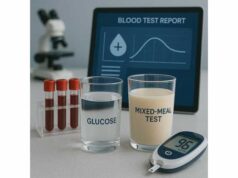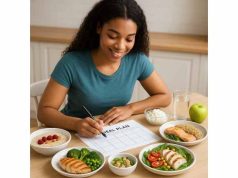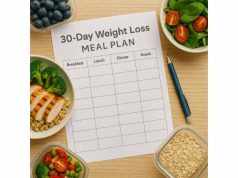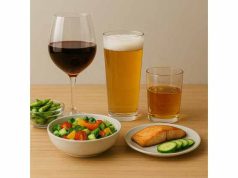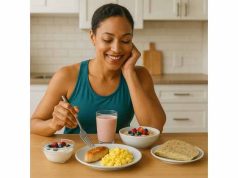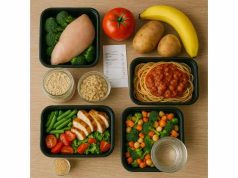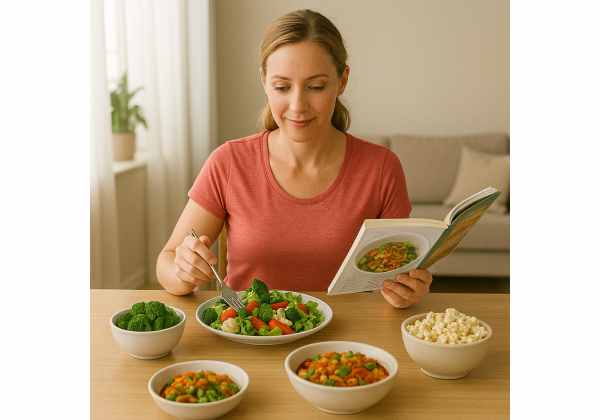
Feeling full while eating fewer calories is not a paradox. It is a strategy called energy density: choose foods that pack fewer calories per bite so your plate looks generous and your stomach senses volume. This guide translates that idea into shopping lists, meal templates, and ready-to-eat swaps you can use tonight. You will learn which foods deliver the most fullness for the fewest calories, how to build satisfying plates, and how to avoid common pitfalls like “salad creep” from dressings and oils. If you want to set your daily calorie and protein targets first, start with our concise calories, macros and planning guide and then plug the numbers into the meals below.
Table of Contents
- What are high-volume foods?
- How to build filling plates
- Best foods and smart swaps
- Meals you can copy
- Mistakes and plateaus
- Safety, digestion and special cases
- Evidence, results and timelines
- Frequently Asked Questions
What are high-volume foods?
High-volume, low-calorie foods deliver lots of physical bulk with relatively few calories. Think leafy greens, watery fruits, broth-based soups, fibrous vegetables, low-fat dairy, and lean proteins. They work because stretch and weight in the stomach, alongside fiber and protein, send strong “I am full” signals to the brain. You eat more food by weight while quietly lowering total calories.
Energy density in plain language
- Very low density (best for volume): non-starchy vegetables, most fruits, broth soups, plain yogurt, low-fat cottage cheese, egg whites, white fish.
- Low to moderate density (helpful): potatoes, beans, lentils, oats, whole grains, popcorn, tofu, lean poultry.
- High density (use measured): oils, butter, nuts, seeds, desserts, cheese, fatty meats.
You do not need to ban high-density foods. You measure them and surround them with high-volume items so plates feel large without blowing your budget.
Why this helps weight loss
- Bigger plates, fewer calories. A 400-calorie salad built with greens, tomatoes, cucumbers, peppers, chickpeas, and a measured vinaigrette covers a dinner plate; 400 calories of nuts fit in your palm.
- Slower eating, steadier appetite. Fiber and water slow gastric emptying, so you stay satisfied longer between meals.
- Better adherence. Large, colorful plates feel like a normal meal, not a diet.
Protein still matters
Volume curbs appetite; protein protects muscle and tightens hunger. Anchor each meal with 25–45 grams of protein and then pile on produce. If you are choosing between diet styles, our core guidance on healthy weight loss basics shows how volume eating fits alongside other tools.
Who thrives with high-volume eating
- People who like big plates and hate feeling restricted.
- Those who struggle with evening snacking—a larger, fiber-rich dinner reduces later cravings.
- Anyone who wants fat loss without complex tracking (though a brief audit helps).
What it is not
It is not “all salad, no satisfaction.” You will use measured amounts of tasty fats, grains, and sauces so food stays enjoyable. The difference is proportion: more bulk from low-calorie foods, less from energy-dense add-ons.
How to build filling plates
You do not need a scale at every meal. Use a plate method that tilts volume in your favor, then plug in your calories and protein. Here is a simple, repeatable blueprint.
Step 1 — Fill half the plate with produce
Leafy greens, broccoli, cauliflower, zucchini, cucumbers, tomatoes, peppers, cabbage, mushrooms, green beans, asparagus. Aim for 2–4 cups across meals. Raw volume looks bigger; cooked vegetables shrink, so load them generously.
Step 2 — Add a palm or two of lean protein
Chicken breast, turkey, white fish, tuna, shrimp, extra-lean beef, pork tenderloin, tofu, tempeh, seitan, cottage cheese, Greek yogurt, eggs or egg whites. Most adults need 1.6–2.2 g/kg body weight daily; split that across meals (e.g., 30–45 g at lunch and dinner, 20–35 g at breakfast).
Step 3 — Include a fist of smart carbs as needed
Potatoes, beans, lentils, quinoa, rice, whole-grain wraps, corn, fruit. Carbs add satisfaction and training fuel. Boiled or baked potatoes are a stand-out: high satiety per calorie, especially with yogurt-based sauces instead of butter.
Step 4 — Finish with measured fats
Olive oil, avocado, nuts, seeds, tahini, pesto, cheese. Use teaspoons and tablespoons, not “eyeballs.” A tablespoon of olive oil adds ~120 calories; two “free pours” can double a meal’s calories.
Step 5 — Broth, crunch, acid
Flavor without bulk calories: broth to cook grains and vegetables, pickles or kraut for acid and crunch, lemon, vinegar, mustard, herbs, spice rubs, low-fat Greek yogurt as a creamy base for sauces.
Portioning without counting
- Two-plate day: big salad-plus-protein lunch, large protein-plus-veg dinner; optional fruit and yogurt snack.
- Three-plate day: smaller versions at breakfast, lunch, and dinner.
- Soups and stews: start with broth, vegetables, and legumes; add protein; finish with measured fats.
If you like visuals, our quick overview of the plate method shows how these sizes map to different calorie targets.
Hydration and texture
Sparkling water, sliced citrus water, or hot tea before and during meals increases fullness. Crunchy vegetables (cabbage, snap peas) slow eating and make low-calorie plates feel generous.
What about eating out?
Order the protein-plus-veg anchor first, then request sauces on the side. Swap fries for a salad or extra vegetables. Ask for an extra side of steamed greens and a lemon wedge; add your own olive oil by the teaspoon.
Best foods and smart swaps
Use this shopper’s map to load your cart with high-volume foods and to swap high-calorie staples for lighter alternatives that still taste great.
Vegetables (all-you-can-pile)
- Leafy: romaine, butter lettuce, arugula, spinach, cabbage.
- Crucifers: broccoli, cauliflower, Brussels sprouts, bok choy.
- Watery and crunchy: cucumber, celery, radish, bell pepper, zucchini, tomatoes.
- Savory bulk: mushrooms, onions, eggplant, green beans, asparagus.
Fruits (portion to preference)
- Top volume per calorie: berries, melon, citrus, kiwi, peaches, plums.
- Higher-calorie but filling: bananas, grapes, mango—keep to a fist-sized portion if you are budgeting tightly.
Proteins (lean, satisfying, versatile)
- Animal: chicken or turkey breast, 90–96% lean beef, pork tenderloin, white fish, tuna, shrimp, eggs, cottage cheese, low-fat Greek yogurt.
- Plant: tofu, tempeh, seitan, edamame, lentils, beans (portion to calories). For a detailed list with serving sizes, scan our curated lean protein options.
Grains and starches (choose the form that fills you)
- Potatoes (boiled, baked, or air-fried), oats, popcorn (air-popped), brown rice, quinoa, barley, corn tortillas, whole-grain wraps.
Fats and flavor (measured)
- Olive oil, avocado, nuts, seeds, tahini, hummus, pesto, parmesan. Use small spoons, cheese curls, and oil misters.
Smart swaps that save hundreds of calories
- Creamy sauces → yogurt bases. Mix 2% Greek yogurt with lemon, garlic, and herbs instead of mayo or cream.
- Tortillas and buns → lettuce cups or thin wraps. Or try small corn tortillas instead of large flour tortillas.
- Fried sides → roasted or air-fried. Potatoes and zucchini crisp beautifully with a teaspoon of oil.
- Granola → high-fiber cereal. Mix a tablespoon of granola for crunch rather than a full bowl.
- Full-sugar drinks → water, seltzer, unsweet tea. Flavor with citrus and fresh mint.
Freezer and pantry MVPs
- Frozen broccoli, spinach, mixed veg, berries, and shrimp—nutrient-dense and always available.
- Beans, lentils, diced tomatoes, low-sodium broth, tuna pouches—fast, filling bases.
- Spices: smoked paprika, cumin, curry powder, chili blend, garlic powder, everything seasoning.
Sauce kit for 60-second flavor
- Citrus-herb: lemon juice, parsley, olive oil (teaspoon), salt.
- Yogurt-dill: Greek yogurt, dill, garlic, lemon.
- Chili-lime: lime juice, chili powder, touch of honey, splash of water.
- Soy-ginger: low-sodium soy sauce, grated ginger, rice vinegar, garlic, cornstarch slurry to thicken.
Meals you can copy
Plug these into your week. Adjust portions to your calories and protein target. Each idea leans on bulky produce plus a solid protein and uses measured fats for flavor.
Breakfast
- Yogurt bowl, big volume: 200 g 2% Greek yogurt, 1 cup berries, 1 tbsp chia, cinnamon; add a tablespoon of crunchy cereal for texture. For more options, see our quick list of high-protein breakfasts.
- Loaded egg scramble: 2–3 eggs or egg whites, mushrooms, spinach, tomatoes; fold in 20–30 g reduced-fat cheese; salsa on top.
- Overnight oats, lighter: ½ cup oats, 150 g yogurt, ½ cup berries, 1 tsp peanut butter stirred in.
Lunch
- Protein salad bowl: romaine, cucumber, tomato, pepper, 120–170 g chicken or tofu, ½ cup beans; 2 tsp olive oil + vinegar.
- Soup-and-sandwich combo: broth-based vegetable soup + turkey wrap (thin wrap, mustard, pickles, big lettuce stack).
- Potato and tuna plate: two small boiled potatoes, 1 can tuna mixed with yogurt-dill, side salad.
Dinner
- Stir-fry for volume: 300–400 g mixed vegetables, 150–200 g shrimp or tofu; finish with 1–2 tsp sesame oil and a drizzle of soy-ginger sauce; serve over cauliflower rice or a small scoop of rice.
- Sheet-pan rainbow: chicken breast, broccoli, peppers, onions; spice rub; roast; finish with lemon.
- Pasta-feel without pasta calories: sautéed zucchini ribbons and mushrooms with turkey meat sauce; parmesan shavings.
Snacks (100–250 calories)
- Cottage cheese with pineapple; apple with powdered peanut butter; air-popped popcorn; carrot sticks with hummus; protein shake with ice and cinnamon.
Dessert that fits
- Berries with a dollop of whipped yogurt; baked apples with cinnamon; chocolate square with tea.
Batch-cook strategy
Roast two trays of vegetables, cook a pot of potatoes, and grill a kilo of chicken or tofu on Sunday. Mix and match all week. If you prefer a fully mapped week at 1,500–1,800 calories, our plug-and-play plan is here: 7-day high-protein template.
Mistakes and plateaus
Volume eating works best when you keep calories quietly in check. These are the usual snags and how to fix them.
“Salad creep” from dressings and oils
Olive oil is healthy and energy-dense. Measure it. Use teaspoons, an oil mister, or vinaigrettes cut with water, citrus, or vinegar. Yogurt-based dressings deliver creaminess for a fraction of the calories.
Protein too low
If dinner ends with grazing, lunch probably lacked protein. Aim for 25–45 g per meal and consider a high-protein afternoon snack (yogurt, shake, cottage cheese).
Carb fear leading to overeating fat
Potatoes, beans, and fruit are high-volume allies. Removing them often pushes you to add more cheese, nuts, and oils. Keep carbs you enjoy in measured portions.
Relying on “diet snacks”
Bars and baked chips are convenient but rarely filling. Swap to fruit + yogurt, vegetables + hummus, or air-popped popcorn and watch appetite improve.
Fiber jump too fast
Going from 10 g to 35 g overnight can cause bloating. Increase vegetables and legumes gradually, drink water, and add a daily walk.
Real plateau vs scale noise
Sodium, hormones, and restaurant meals can mask progress for a few days. Compare weekly averages and waist measurements. If nothing changes for 3–4 weeks, trim 5–10% of calories (mostly from added fats and treats) or add 2,000–3,000 daily steps. For a wider troubleshooting checklist, scan these common diet mistakes.
Safety, digestion and special cases
High-volume eating is safe for most adults, but a few groups should individualize.
Sensitive digestion
- FODMAP concerns or IBS: onions, garlic, certain beans, and some fruits can trigger symptoms. Choose lower-FODMAP vegetables (zucchini, carrots, spinach, bell peppers) and canned, well-rinsed lentils or firm tofu.
- Fiber ramp: increase vegetables and legumes over 2–3 weeks, drink water, and use cooked vegetables if raw salads bother you.
Diabetes or glucose issues
Large portions of fruit and starch are fine when paired with protein and portioned. Monitor glucose responses and coordinate any changes with your clinician.
Athletes and heavy training
You still want volume, but not at the expense of fueling. Keep carbs around workouts, and use lower-fiber choices close to training (rice, potatoes, ripe bananas, yogurt). For everyday hydration that supports appetite control and performance, review practical fiber targets and swaps as you adjust intake.
Medications and medical conditions
If you take medications that affect blood sugar or appetite, or if you have kidney, liver, or GI disorders, discuss changes with your healthcare provider.
Kids and older adults
Kids need energy for growth; older adults need higher protein to protect muscle. Volume foods still help, but calorie goals and protein distribution should reflect age, activity, and medical context.
Evidence, results and timelines
High-volume eating works because it aligns biology with behavior. Fiber, water, and protein create fullness signals while you reduce calories quietly. When portions look big, adherence improves; when protein is steady, muscle stays. That combination produces consistent fat loss.
What results look like
- Weeks 1–2: appetite stabilizes as you swap refined snacks for bulky produce and lean proteins. Water shifts may move the scale quickly.
- Weeks 3–8: steady fat loss—often 0.5–1.0% of body weight per week with a moderate deficit.
- Months 3+: plateaus happen. Audit oils, nuts, cheese, and restaurant meals; add steps; keep protein high.
How to measure progress
- Track weekly weight averages and waist circumference.
- Note energy and consistency: are you hitting protein, produce, and steps?
- Use a simple photo once every two weeks under similar light and posture.
When to pivot
If large salads and soups leave you uncomfortably bloated despite a slow fiber ramp, shift emphasis toward cooked vegetables, blended soups, tender fruit, and yogurt. If you are not enjoying meals, re-introduce measured amounts of higher-calorie favorites and watch the weekly average.
Bottom line
High-volume foods make eating less feel like eating plenty. Combine them with enough protein, measured fats, and a calorie target you can repeat on ordinary days, and progress follows.
Frequently Asked Questions
What are the best high-volume foods to start with?
Begin with leafy greens, cucumbers, tomatoes, mushrooms, zucchini, broccoli, berries, melon, potatoes, Greek yogurt, cottage cheese, tofu, and white fish. These deliver bulk, water, and protein or fiber so you feel full on fewer calories and can stick to your plan.
Do I have to count calories if I focus on volume?
Not always. Many people lose weight by using plate templates, measuring oils and calorie-dense add-ons, and eating two to four planned meals. If progress stalls for 3–4 weeks, track intake for seven to ten days to find hidden calories, then return to simple systems.
Can I eat fruit freely on a low-calorie plan?
Yes, with portions. Most fruits are high volume and hydrating. Berries, melon, citrus, kiwi, and peaches offer great fullness per calorie. If you are tightly budgeting calories, keep higher-calorie fruits like bananas or grapes to a fist-sized portion with protein.
Are potatoes “fattening” or helpful?
Potatoes are naturally low in calories per gram and very filling when boiled, baked, or air-fried. Problems arise from add-ons like butter, oil, and cheese. Pair potatoes with yogurt-based sauces and vegetables, and measure fats to keep calories in check.
How do I handle eating out without overdoing calories?
Order a protein-and-veg anchor, ask for sauces and dressings on the side, and swap fries for a salad or extra vegetables. Share dessert or choose fruit-forward options. Keep the weekly average by balancing richer meals with lighter, protein-heavy meals the next day.
Why did I feel bloated when I increased vegetables?
A sudden fiber jump can cause gas and bloating. Increase volume gradually over two to three weeks, drink water, try cooked vegetables and blended soups, and add a daily walk. If symptoms persist, choose lower-FODMAP options or speak with your clinician.
References
- Calorie reformulation: a systematic review and meta-analysis examining the effect of manipulating food energy density on daily energy intake 2022 (Systematic Review & Meta-analysis)
- Systematic review and meta‐analysis of protein intake to support muscle mass and function in healthy adults 2022 (Systematic Review & Meta-analysis)
- Potatoes Compared with Rice in Meals with either Animal or Plant Protein Reduce Postprandial Glycemia and Increase Satiety in Healthy Adults: A Randomized Crossover Study 2024 (RCT)
- Benefits of Fiber-Enriched Foods on Satiety and Parameters of Human Well-Being in Adults with and without Cardiometabolic Risk 2023 (RCT)
- How much protein can the body use in a single meal for muscle-building? Implications for daily protein distribution 2018 (Review)
Disclaimer
This article is educational and does not replace personalized medical advice. Speak with your healthcare professional before changing your diet—especially if you have diabetes, gastrointestinal disorders, kidney or liver disease, are pregnant or breastfeeding, or have a history of disordered eating. Adjust fiber slowly, hydrate, and tailor portions to your energy needs.
Share and follow
If this guide helped you, please share it with a friend who wants bigger plates and better appetite control. For new articles and practical templates, follow us on the social platform you use most—Facebook, X, or another network you prefer.

